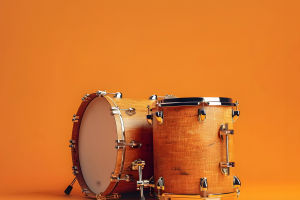The violin and cello are two of the most beloved string instruments in the world.
They are frequently featured in orchestras, chamber groups, and solo performances, each bringing a unique voice to musical pieces.
Despite their shared heritage in the violin family, they differ significantly in size, sound range, playing style, and musical roles. Understanding these differences can deepen our appreciation for each instrument’s unique qualities.
1. Size and Shape
One of the most noticeable differences between a violin and a cello is their size. The violin is much smaller, measuring around 14 inches (35 cm) in body length, making it easy to hold and play on the shoulder. The cello, on the other hand, is much larger, with a body length of about 30 inches (76 cm) and needs to be played while resting on the floor with the aid of an endpin to support its weight. This size difference is a major factor in how each instrument is played and how it produces sound.
2. Range and Sound
The violin has a higher pitch range and is the soprano voice in the string family, producing bright, piercing, and often melodic tones. It can play notes from G3 (the G below middle C) up to C8, although it typically plays within a more limited range in most compositions. The violin’s high range allows it to shine in fast-paced and intricate passages, making it an ideal instrument for carrying melodies in many pieces.
In contrast, the cello has a lower, rich, and resonant tone, covering the baritone range. It can play from C2 (two octaves below middle C) up to G5 or A5 in advanced playing, and its deeper sound is often described as warm and soulful. This gives the cello a grounding presence in orchestras and ensembles, where it often plays harmonic and rhythmic roles, though it’s also well-suited to lyrical, expressive solos.
3. Playing Position and Technique
Another major difference lies in the way each instrument is held and played. The violin is held horizontally and supported by the left shoulder and chin, allowing the player to easily shift positions along the neck with their left hand while using the right hand to bow. This position contributes to the violin’s agility and versatility, enabling quick, high-pitched runs and intricate fingerings.
The cello, however, is positioned vertically between the player’s knees, with the instrument’s body resting on the floor via an endpin. This playing posture gives the cellist a more grounded stance, and the larger fingerboard requires more extensive finger movements. Because of its size, cellists use a different bowing technique and more arm movement to produce sound, resulting in slower but more powerful strokes. This position is ideal for the deep, resonant sounds for which the cello is known.
4. Bow Size and Technique
The bows used for the violin and cello also differ in size and handling. A violin bow is shorter and lighter, typically measuring around 29 inches (74 cm), allowing for quicker, more delicate strokes suitable for the violin’s fast, intricate melodies. The cello bow is slightly shorter but heavier, providing the additional weight needed to create a fuller sound on the cello’s thicker strings.
Due to the differences in size and tension of each instrument’s strings, the technique for bowing is also distinct. Cellists apply more pressure to achieve the desired resonance and may use slower bow movements, whereas violinists tend to use lighter, more fluid strokes to suit the instrument’s agile, high-pitched sound.
5. Role in an Orchestra or Ensemble
In orchestras and ensembles, the violin and cello serve different musical roles due to their distinct sound ranges. The violin, with its high-pitched and bright sound, often carries the main melody and plays the leading role in most compositions. First violins play the melody, while second violins provide harmony and texture, contributing to the richness of the sound.
The cello, meanwhile, generally plays a supportive role, anchoring the harmonic foundation with deep, rich tones. Cellos are often part of the rhythm section along with the double bass, but they also frequently get solo passages, where their warm sound adds emotional depth to the music. In string quartets, the cello often provides the bass line, balancing the higher tones of violins and viola.
6. Repertoire and Solo Performance
Both the violin and cello have extensive solo repertoires, though they offer different musical experiences. The violin’s brilliance and agility make it popular for complex, technically demanding solo pieces. Famous violin concertos by composers like Mendelssohn, Tchaikovsky, and Brahms showcase the instrument’s virtuosity.
The cello has its own celebrated solo pieces, often focusing on its lyrical and expressive capabilities. Pieces like Bach’s Cello Suites and Dvořák’s Cello Concerto highlight its rich tone and emotional depth. Cellos often excel in slower, soulful pieces, though they are also capable of showcasing technical brilliance.
The violin and cello are both indispensable members of the string family, each contributing unique textures and emotions to musical compositions. While the violin brings agility, brightness, and melody, the cello offers warmth, depth, and a grounding presence. Understanding these differences enriches our appreciation of each instrument and the roles they play in classical and contemporary music alike.
These differences make the violin and cello truly distinct, but when played together, they create a harmonious blend that adds beauty and complexity to the music world.


